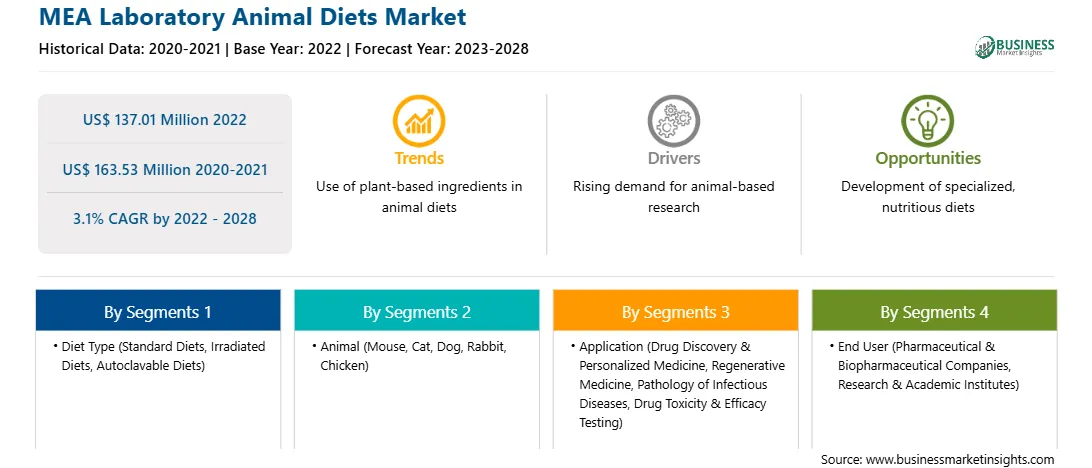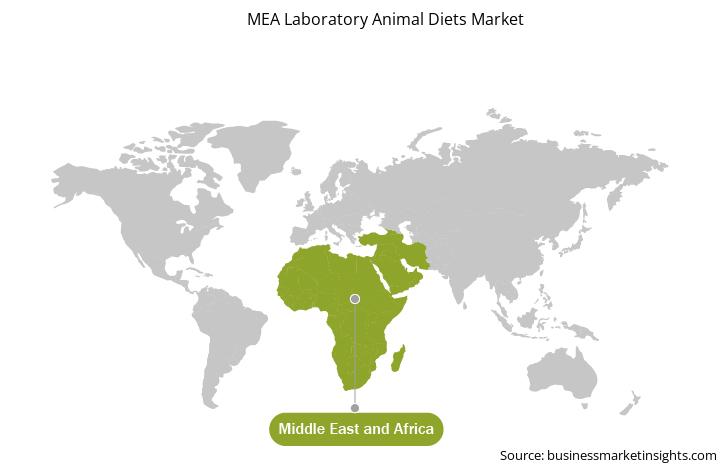The laboratory animal diets market in MEA is expected to grow from US$ 137.01 million in 2022 to US$ 163.53 million by 2028; it is estimated to grow at a CAGR of 3.1% from 2022 to 2028.
Rising Demand for Humanized Mice Models Boost MEA Laboratory Animal Diets Market
Basic research, safety assessment for large molecule therapeutics, simulation of a few human-specific infectious diseases, and efficacy testing of immunotherapy approaches use humanized mice models. Humanized mice models are generally used to study cancer genetics, autoimmune diseases, regenerative medicine, human hematopoiesis, infectious diseases, transplantation, and autoimmunity. They enhance the translational value of preclinical research by enabling researchers to understand disease pathways better. Both mice and human genes and proteins are examined to determine the optimal expression and functionality of the human protein in a mouse environment. Recent mice models also reflect hematopoiesis, natural immunity, neurobiology, and molecular signaling pathways that influence disease pathobiology. These mice models also aid studies on human pathobiology, natural disease processes, and therapeutic efficacy across a broad spectrum of human diseases. Overall, humanized mice models offer low-cost, high-throughput studies on infection or degeneration in natural pathogen-host cells and the opportunity to test disease transmission and eradication. Humanized mice models have been xenografted with human cells or engineered to express human genes. These mice are used extensively to elucidate and understand human physiology and the etiology of human-specific infections. These models are used in biomedical research to develop therapeutics due to their numerous advantages such as small size, short reproductive cycle, ease of handling, and increased genomic similarity to humans. They are crucial in preclinical research studies because they imitate the symptoms of several human-specific diseases and can be used to study the efficacy and safety of immunotherapy approaches.
In addition, humanized mice models have played an important role in designing and developing vaccines and antibody-based therapies for COVID-19. The models, developed after the onset of the COVID-19 outbreak, could further help provide a more profound and better understanding of the infection and effectiveness of antiviral therapeutics and support the development of efficient drugs and therapies to treat the disease. Hence, humanized mice models will continue to be widely used in the coming years. Diet plays an important role in the immune response given by humans to a particular type of disease. Therefore, it is important to take care of the diet provided to the humanized mice model. Hence, humanized mice models are also given a diet similar to the human diet. Thus, the growing demand for humanized mice models will create an opportunity for the growth of the laboratory animal diet market during the forecast period.
Market Overview
The MEA Laboratory Animal Diet market is segmented into Saudi Arabia, the UAE, South Africa, and the Rest of MEA. Animals are commonly used for scientific purposes in the region. The number of animals used in research has increased with the advancement of research and development in medical technology. Every year, millions of experimental animals are used in South Arabia for the purpose of research. Various animals such as mice, rats, hamsters, rabbits, fishes (examples—zebra fish and trout), birds (mainly chicken), guinea pigs, amphibians (xenopus frogs), primates, dogs, cats etc. are being used in research for a long time. Moreover, they are used to obtain products such as vaccines, antibiotics etc. which are used in treatments as well as diagnostics.
MEA Laboratory Animal Diets Market Revenue and Forecast to 2028 (US$ Million)
MEA Laboratory Animal Diets Market Segmentation
The MEA laboratory animal diets market is segmented into diet type, animal, application, end user, and country.
Based on diet type, the market is segmented into standard diets, irradiated diets, and autoclavable diets. The standard diets segment registered the largest market share in 2022.
Based on animal, the MEA laboratory animal diets market is segmented into mouse, cat, dog, rabbit, chicken, and others. The mouse segment registered the largest market share in 2022.
Based on application, the MEA laboratory animal diets market is segmented into drug discovery and personalized medicines, regenerative medicines, pathology of infectious disease, drug toxicity and efficacy testing, and others. The drug discovery and personalized medicine segment registered the largest market share in 2022.
Based on end user, the MEA laboratory animal diets market is segmented into pharmaceutical & biopharmaceutical companies, research & academic institutes, and others. The pharmaceutical & biopharmaceutical companies segment registered the largest market share in 2022.
Based on country, the MEA laboratory animal diets market is segmented into Saudi Arabia, South Africa, the UAE, and the Rest of MEA. Saudi Arabia dominated the market in 2022.
Altromin Spezialfutter GmbH & Co. KG, Bio-Serv, Envigo, Krishna Valley Agrotech LLP, LabDiet, Research Diets Inc., SAFE, Special Diet Services, and Specialty Feeds are the leading companies operating in the laboratory animal diets market in the MEA.
Strategic insights for the MEA Laboratory Animal Diets provides data-driven analysis of the industry landscape, including current trends, key players, and regional nuances. These insights offer actionable recommendations, enabling readers to differentiate themselves from competitors by identifying untapped segments or developing unique value propositions. Leveraging data analytics, these insights help industry players anticipate the market shifts, whether investors, manufacturers, or other stakeholders. A future-oriented perspective is essential, helping stakeholders anticipate market shifts and position themselves for long-term success in this dynamic region. Ultimately, effective strategic insights empower readers to make informed decisions that drive profitability and achieve their business objectives within the market.

| Report Attribute | Details |
|---|---|
| Market size in 2022 | US$ 137.01 Million |
| Market Size by 2028 | US$ 163.53 Million |
| CAGR (2022 - 2028) | 3.1% |
| Historical Data | 2020-2021 |
| Forecast period | 2023-2028 |
| Segments Covered |
By Diet Type
|
| Regions and Countries Covered | Middle East and Africa
|
| Market leaders and key company profiles |
|
The geographic scope of the MEA Laboratory Animal Diets refers to the specific areas in which a business operates and competes. Understanding local distinctions, such as diverse consumer preferences (e.g., demand for specific plug types or battery backup durations), varying economic conditions, and regulatory environments, is crucial for tailoring strategies to specific markets. Businesses can expand their reach by identifying underserved areas or adapting their offerings to meet local demands. A clear market focus allows for more effective resource allocation, targeted marketing campaigns, and better positioning against local competitors, ultimately driving growth in those targeted areas.

The MEA Laboratory Animal Diets Market is valued at US$ 137.01 Million in 2022, it is projected to reach US$ 163.53 Million by 2028.
As per our report MEA Laboratory Animal Diets Market, the market size is valued at US$ 137.01 Million in 2022, projecting it to reach US$ 163.53 Million by 2028. This translates to a CAGR of approximately 3.1% during the forecast period.
The MEA Laboratory Animal Diets Market report typically cover these key segments-
The historic period, base year, and forecast period can vary slightly depending on the specific market research report. However, for the MEA Laboratory Animal Diets Market report:
The MEA Laboratory Animal Diets Market is populated by several key players, each contributing to its growth and innovation. Some of the major players include:
The MEA Laboratory Animal Diets Market report is valuable for diverse stakeholders, including:
Essentially, anyone involved in or considering involvement in the MEA Laboratory Animal Diets Market value chain can benefit from the information contained in a comprehensive market report.